Empirical Scientific Findings (peer-reviewed)
Intense Short-Video-Based Social Media Use reduces the P300 Event-Related Potential Component in a Visual Oddball Experiment: A Sign for Reduced Attention
Peter Walla & Yu Zheng
Walla, P.; Zheng, Y. Intense Short-Video-Based Social Media Use reduces the P300 Event-Related Potential Component in a Visual Oddball Experiment: A Sign for Reduced Attention. Life 2024, 14, 290. https://doi.org/10.3390/life14030290

Abstract: The birth and following growth of social media platforms has influenced a lot. In addition to beneficial features, it has long-been noticed that heavy consumption of social media can have negative effects beyond a simple lack of time for other things. Of particular interest is the idea that consuming
short videos lasting only fractions of a minute and watched one after another can lead to deficits in concentration and attention. Completing the existing literature that already reports evidence for attention deficits related to heavy social media use, the present study aims to contribute to this acute topic by adding neurophysiological data to it. In particular, this study made use of a well-known experimental paradigm, which is able to detect attention-related changes on a neurophysiological level. The so-called oddball paradigm was applied and the hypothesis that heavy social media users mainly consuming short videos show a reduced P300 event-related potential (ERP) component was tested, which has been found to reflect attention-related brain functions. For this, we invited twenty-nine participants and designed a visual oddball experiment including a white circle on black background as the low-frequency target stimulus and a white triangle on black background as the high-frequency non-target stimulus. On the basis of their self-reported short-video-based social media usage habits, all participants were grouped into heavy (more than 4 h daily usage) and regular (below 3 h daily usage) users, and finally data from 14 heavy and 15 regular users were further analyzed. It was found that only regular users show a clear P300 ERP component, while this particular brain potential amplitude reflecting attentional processes was significantly reduced in heavy users. This result provides empirical brain imaging evidence that heavy short-video-based social media use indeed affects attentional brain processes in a negative way.
Brain Activities Show There Is Nothing Like a Real Friend in Contrast to Influencers and Other Celebrities Peter Walla, Dimitrios Külzer, Annika Leeb, Lena Maoidl, Stefan Kalt
(Walla, P.; Külzer, D.; Leeb, A.; Moidl, L.; Kalt, S. Brain Activities Show There Is Nothing Like a Real Friend in Contrast to Influencers and Other Celebrities. Brain Sci. 2023, 13, 831. https://doi.org/10.3390/brainsci13050831)

Abstract: Especially for young people, influencers and other celebrities followed on social media evoke affective closeness that in their young minds seems real even though it is fake. Such fake friendships are potentially problematic because of their felt reality on the consumer side while lacking any inversely felt true closeness. The question arises if the unilateral friendship of a social media user is equal or at least similar to real reciprocal friendship. Instead of asking social media users for explicit responses (conscious deliberation), the present exploratory study aimed to answer this question with the help of brain imaging technology. Thirty young participants were first invited to provide individual lists including (i) twenty names of their most followed and loved influencers or other celebrities (fake friend names), (ii) twenty names of loved real friends and relatives (real friend names) as well as (iii) twenty names they do not feel any closeness to (no friend names). They then came to the Freud CanBeLab (Cognitive and Affective Neuroscience and Behavior Lab) where they were shown their selected names in a random sequence (two rounds), while their brain activities were recorded via electroencephalography (EEG) and later calculated into event-related potentials (ERPs). We found short (ca. 100 ms) left frontal brain activity starting at around 250 ms post-stimulus to process real friend and no friend names similarly, while both ERPs differed from those elicited by fake friend names. This is followed by a longer effect (ca. 400 ms), where left and right frontal and temporoparietal ERPs also differed between fake and real friend names, but at this later processing stage, no friend names elicited similar brain activities to fake friend names in those regions. In general, real friend names elicited the most negative going brain potentials (interpreted as highest brain activation levels). These exploratory findings represent objective empirical evidence that the human brain clearly distinguishes between influencers or other celebrities and close people out of real life even though subjective feelings of closeness and trust can be similar. In summary, brain imaging shows there is nothing like a real friend. The findings of this study might be seen as a starting point for future studies using ERPs to investigate social media impact and topics such as fake friendship.
Electroencephalography (EEG) shows that trust and mistrust differ between brands and political institutions
Peter Walla, Stefan Kalt, and Dimitrios Külzer
in press

Abstract: This study provides significant neurophysiological evidence that i) brands and political institutions are processed differently in frontal brain regions and ii) that brain activity differences between trust and mistrust vary between those two stimulus categories. Brain activity differences between both stimulus categories were found between approximately 200ms and 500ms at frontal, cortical regions. Different brain activities elicited by trusted versus mistrusted political institutions occurred dominantly at left frontal regions roughly from 200ms to 500ms peaking at about 330ms after stimulus onset. On the other hand, different brain activities elicited by trusted versus mistrusted brands occurred dominantly at right frontal regions roughly from 700ms to 900ms peaking at about 780ms after stimulus onset.
All findings are strongly supported by statistical analysis. Although these findings are difficult to interpret, they provide support for earlier findings on trust-related brain activities being found in frontal cortical regions. In addition, this study also supports the notion that trust and mistrust are indeed no simple, but rather complex constructs that vary across stimulus categories.
Hierarchy and dynamics of self-referential processing: The non-personal Me1 and the personal Me2 elicited via single words Peter Walla and Cornelia Herbert
(Peter Walla & Cornelia Herbert | Sirous Mobini (Reviewing Editor) (2015) Hierarchy and dynamics of self-referential processing: The non-personal Me1 and the personal Me2 elicited via single words, Cogent Psychology, 2:1)

Abstract: Recent electroencephalography (EEG) studies accumulated evidence that support a dynamic view of the self (multiple aspect theory). In this study, we test the specific hypothesis of the multiple aspect theory of the self by using EEG data from the HisMine paradigm. In the HisMine paradigm German pronouns are visually presented in a stream of additional stimuli, while changes in brain activity are determined by means of EEG. At an early cortical processing stage, the presentation of the possessive pronouns “mein” (“my’’), “sein” (“his”) and “dein” (“your”) elicited significantly differ-ent brain activities when compared to the non-personal pronoun “ein” (“a”). At a later processing stage, cortical processing of the self-related possessive pronoun ("mein") differed from the processing of all other possessive and the non-personal pronoun. In line with previous observations (and the multiple aspect theory of the self), the early effect (here referred to as Me1) was found at specifically left occipito-parietal electrode locations (e.g. PO9), whereas the later effect (here referred to as Me2) occurred specifi-cally at the left fronto-temporal electrode site, F7. This finding supports the idea that the human self is consisting of multiple aspects. Potential implications are discussed.
Can Evaluative Conditioning Change Well-Established Attitudes Towards Popular Brands? Your Brain Says Yes Even Though Your Mouth Says No
Shannon Bosshard, Monika Koller, Peter Walla
(Bosshard, S.; Koller, M.; Walla, P. Can Evaluative Conditioning Change Well-Established Attitudes Towards Popular Brands? Your Brain Says Yes Even Though Your Mouth Says No. Brain Sci. 2019, 9, 106. https://doi.org/10.3390/brainsci9050106)
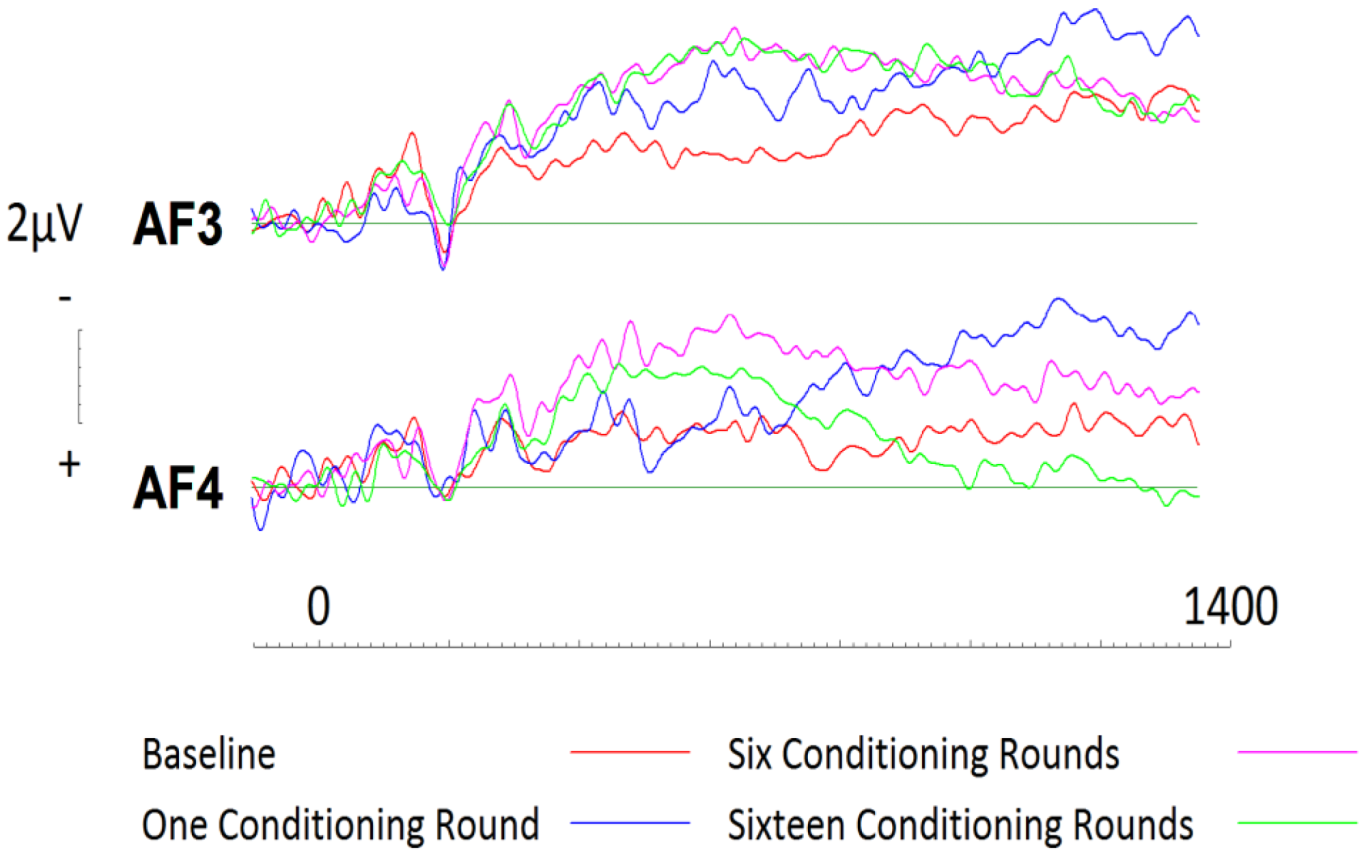
Abstract: In the present study, using both implicit and explicit measures, we addressed the issue of whether strongly developed relationships towards brands could be modified through the use of evaluative conditioning. Using an online survey, individual participant brand lists were created, and formed the basis of this experiment. Participants were then exposed to conditioning during a longitudinal study. Throughout the experiment, a combination of explicit and implicit measures was used to assess changes in attitude. Specifically, participants were asked to rate the brand names on a Likert-type scale. Simultaneously, changes in the brains electrical activity in response to the brands were recorded via electroencephalography (EEG). Upon completion of this task, participants underwent two Implicit Association Tests (IAT; one for liked brands and one for disliked brands). There were two main findings of this study. Firstly, no significant changes in attitude were observed via the use of explicit measures, and those that were found relating to the IAT were regarded as questionable. Secondly, EEG presented consistent results which showed that conditioning elicited changes in cortical activity towards both liked and disliked brands, which suggest it may be a useful tool in measuring the impact of evaluative conditioning that is not reflected in verbal responses.
Established liked versus disliked brands: Brain activity, implicit associations and explicit responsesObjective Measures of Emotion During Virtual Walks through Urban Environments
Shannon Bosshard, Jesse Bourke, Sajeev Kunaharan, Monika Koller, Peter Walla
(Shannon S. Bosshard, Jesse D. Bourke, Sajeev Kunaharan, Monika Koller & Peter Walla | Jarmo Heinonen (Reviewing Editor) (2016) Established liked versus disliked brands: Brain activity, implicit associations and explicit responses, Cogent Psychology, 3:1, DOI: 10.1080/23311908.2016.1176691)
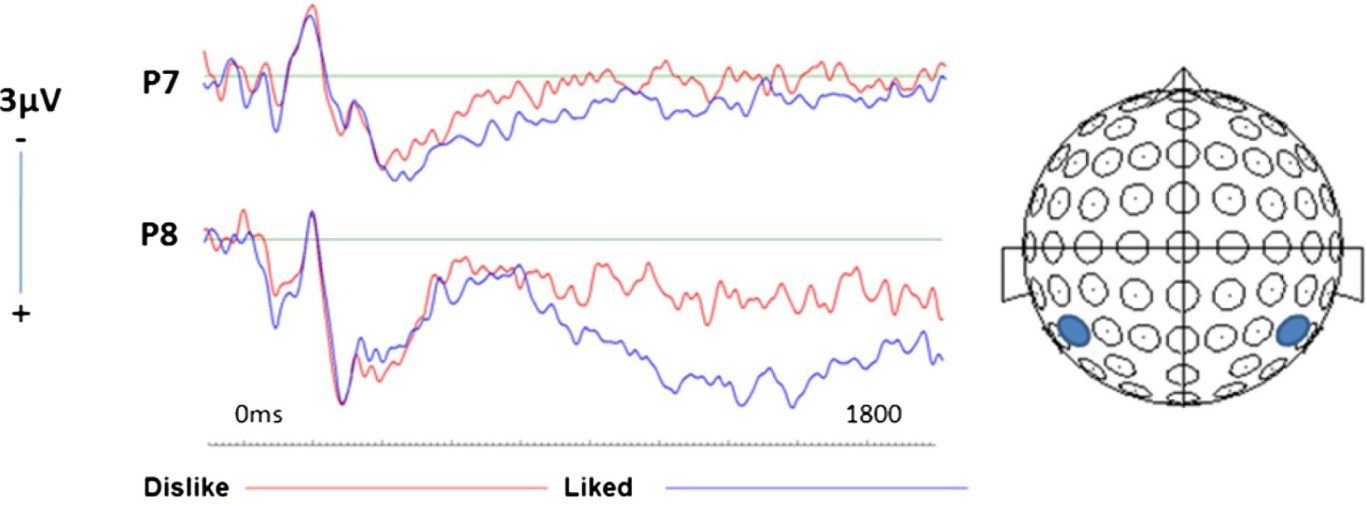
Abstract: Consumers’ attitudes towards established brands were tested using implicit and explicit measures. In particular, late positive potential (LPP) effects were assessed as an implicit neurophysiological measure of motivational significance. The Implicit Association Test (IAT) was used as an implicit behavioural measure of valence-related aspects (affective content) of brand attitude. We constructed individualised stimulus lists of liked and disliked brand types from participants’ subjective pre-assessment. Participants then re-rated these visually presented brands whilst brain potential changes were recorded via electroencephalography (EEG). First, self-report measures during the test confirmed pre-assessed attitudes underlining consistent explicit rating performance. Second, liked brands elicited significantly more positive going waveforms (LPPs) than disliked brands over right parietal cortical areas starting at about 800 ms post stimulus onset (reaching statistical significance at around 1,000 ms) and lasting until the end of the recording epoch (2,000 ms). In accordance to the literature, this finding is interpreted as reflecting positive affect-related motivational aspects of liked brands. Finally, the IAT revealed that both liked and disliked brands indeed are associated with affect-related valence. The increased levels of motivation associated with liked brands is interpreted as potentially reflecting increased purchasing intention, but this is of course only speculation at this stage.
Do EEG and Startle Reflex Modulation Vary with Self-Reported Aggression in Response to Violent Images?
Sajeev Kunaharan, Sean Halpin, Thiagarajan Sitharthan, Peter Walla
(Kunaharan, S.; Halpin, S.; Sitharthan, T.; Walla, P. Do EEG and Startle Reflex Modulation Vary with Self-Reported Aggression in Response to Violent Images? Brain Sci. 2019, 9, 298. https://doi.org/10.3390/brainsci9110298)

Abstract: Increased violence and aggressive tendencies are a problem in much of the world and are often symptomatic of many other neurological and psychiatric conditions. Among clinicians, current methods of diagnosis of problem aggressive behaviour rely heavily on the use of self-report measures as described by the Diagnostic and Statistical Manual of Mental Disorders 5th Edition (DSM-5) and International Classification of Diseases 10th revision (ICD-10). This approach does not place adequate emphasis on objective measures that are potentially sensitive to processes not feeding into subjective self-report. Numerous studies provide evidence that attitudes and affective content can be processed without leading to verbalised output. This exploratory study aimed to determine whether individuals in the normal population, grouped by self-reported aggression, differed in subjective versus objective affective processing. Participants (N = 52) were grouped based on their responses to the Buss–Durkee Hostility Inventory. They were then presented with affect-inducing images while brain event-related potentials (ERPs) and startle reflex modulation (SRM) were recorded to determine non-language-based processes. Explicit valence and arousal ratings for each image were taken to determine subjective affective effects. Results indicated no significant group differences for explicit ratings and SRM. However, ERP results demonstrated significant group differences between the ‘pleasant’ and ‘violent’ emotion condition in the frontal, central and parietal areas across both hemispheres. These findings suggest that parts of the brain process affective stimuli different to what conscious appraisal comes up with in participants varying in self-reported aggression.
Objective Measures of Emotion During Virtual Walks through Urban Environments
Moritz Geiser, Peter Walla
(Geiser, M.; Walla, P. Objective Measures of Emotion During Virtual Walks through Urban Environments. Appl. Sci. 2011, 1, 1-11. https://doi.org/10.3390/app1010001)

Abstract: Previous studies were able to demonstrate different verbally stated affective responses to environments. In the present study we used objective measures of emotion. We examined startle reflex modulation as well as changes in heart rate and skin conductance while subjects virtually walked through six different areas of urban Paris using the StreetView tool of Google maps. Unknown to the subjects, these areas were selected based on their median real estate prices. First, we found that price highly correlated with subjective rating of pleasantness. In addition, relative startle amplitude differed significantly between the area with lowest versus highest median real estate price while no differences in heart rate and skin conductance were found across conditions. We conclude that interaction with environmental scenes does elicit emotional responses which can be objectively measured and quantified. Environments activate motivational and emotional brain circuits, which is in line with the notion of an evolutionary developed system of environmental preference. Results are discussed in the frame of environmental psychology and aesthetics.
Conscious and Non-Conscious Measures of Emotion: Do They Vary with Frequency of Pornography Use?
Sajeev Kunaharan, Sean Halpin, Thiagarajan Sitharthan, Shannon Bosshard, Peter Walla
(Kunaharan, S.; Halpin, S.; Sitharthan, T.; Bosshard, S.; Walla, P. Conscious and Non-Conscious Measures of Emotion: Do They Vary with Frequency of Pornography Use? Appl. Sci. 2017, 7, 493. https://doi.org/10.3390/app7050493)
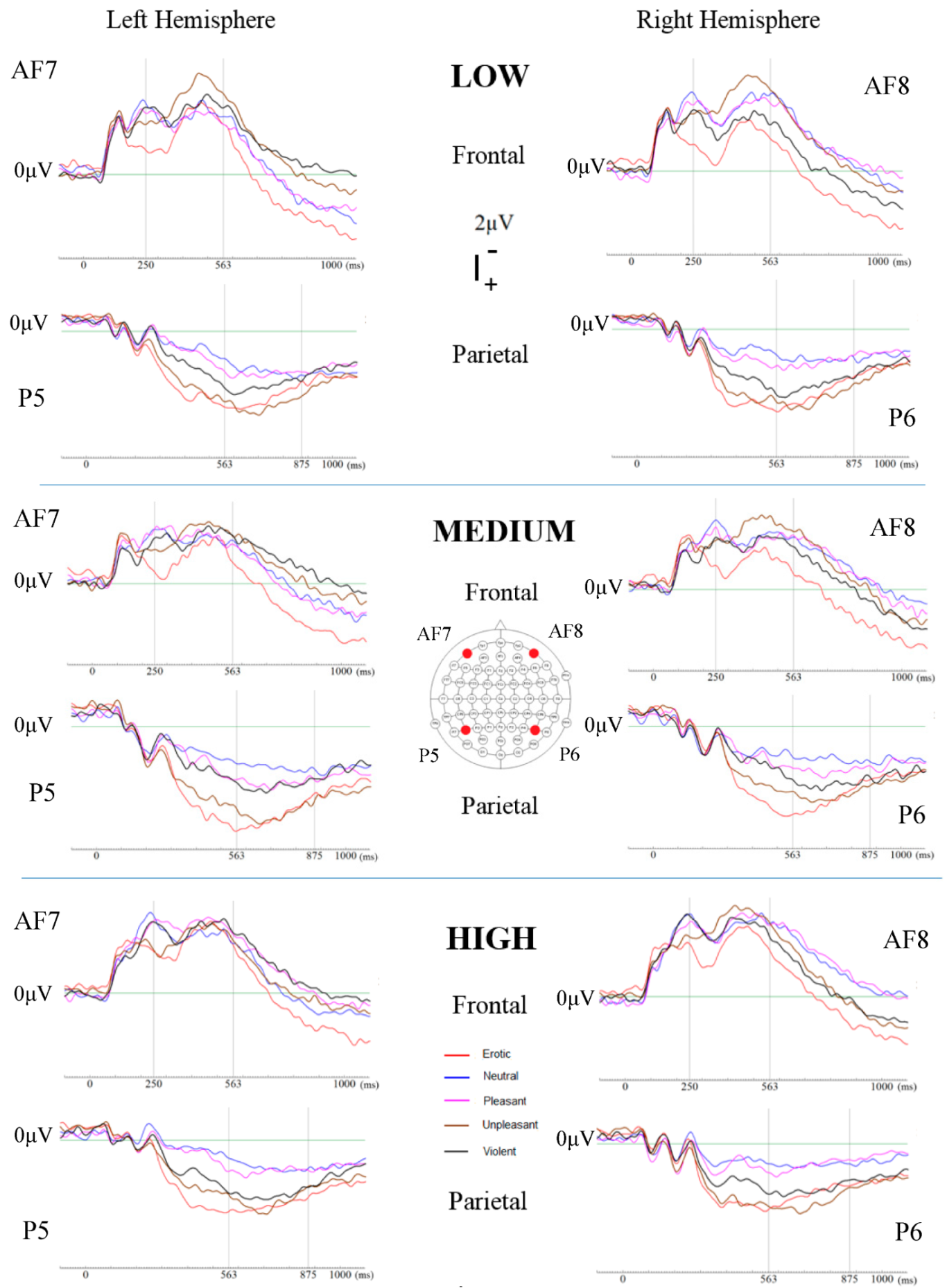
Abstract: Increased pornography use has been a feature of contemporary human society, with technological advances allowing for high speed internet and relative ease of access via a multitude of wireless devices. Does increased pornography exposure alter general emotion processing? Research in the area of pornography use is heavily reliant on conscious self-report measures. However, increasing knowledge indicates that attitudes and emotions are extensively processed on a non-conscious level prior to conscious appraisal. Hence, this exploratory study aimed to investigate whether frequency of pornography use has an impact on non-conscious and/or conscious emotion processes. Participants (N = 52) who reported viewing various amounts of pornography were presented with emotion inducing images. Brain Event-Related Potentials (ERPs) were recorded and Startle Reflex Modulation (SRM) was applied to determine non-conscious emotion processes. Explicit valence and arousal ratings for each image presented were also taken to determine conscious emotion effects. Conscious explicit ratings revealed significant differences with respect to “Erotic” and “Pleasant” valence (pleasantness) ratings depending on pornography use. SRM showed effects approaching significance and ERPs showed changes in frontal and parietal regions of the brain in relation to “Unpleasant” and “Violent” emotion picture categories, which did not correlate with differences seen in the explicit ratings. Findings suggest that increased pornography use appears to have an influence on the brain’s non-conscious responses to emotion-inducing stimuli which was not shown by explicit self-report.
Social Perception of Faces: Brain Imaging and Subjective Ratings
Peter Walla, Minah Chang, Katrin Schäfer, Sonja Windhager
(Walla, P.; Chang, M.; Schaefer, K.; Windhager, S. Social Perception of Faces: Brain Imaging and Subjective Ratings. Brain Sci. 2020, 10, 861. https://doi.org/10.3390/brainsci10110861)
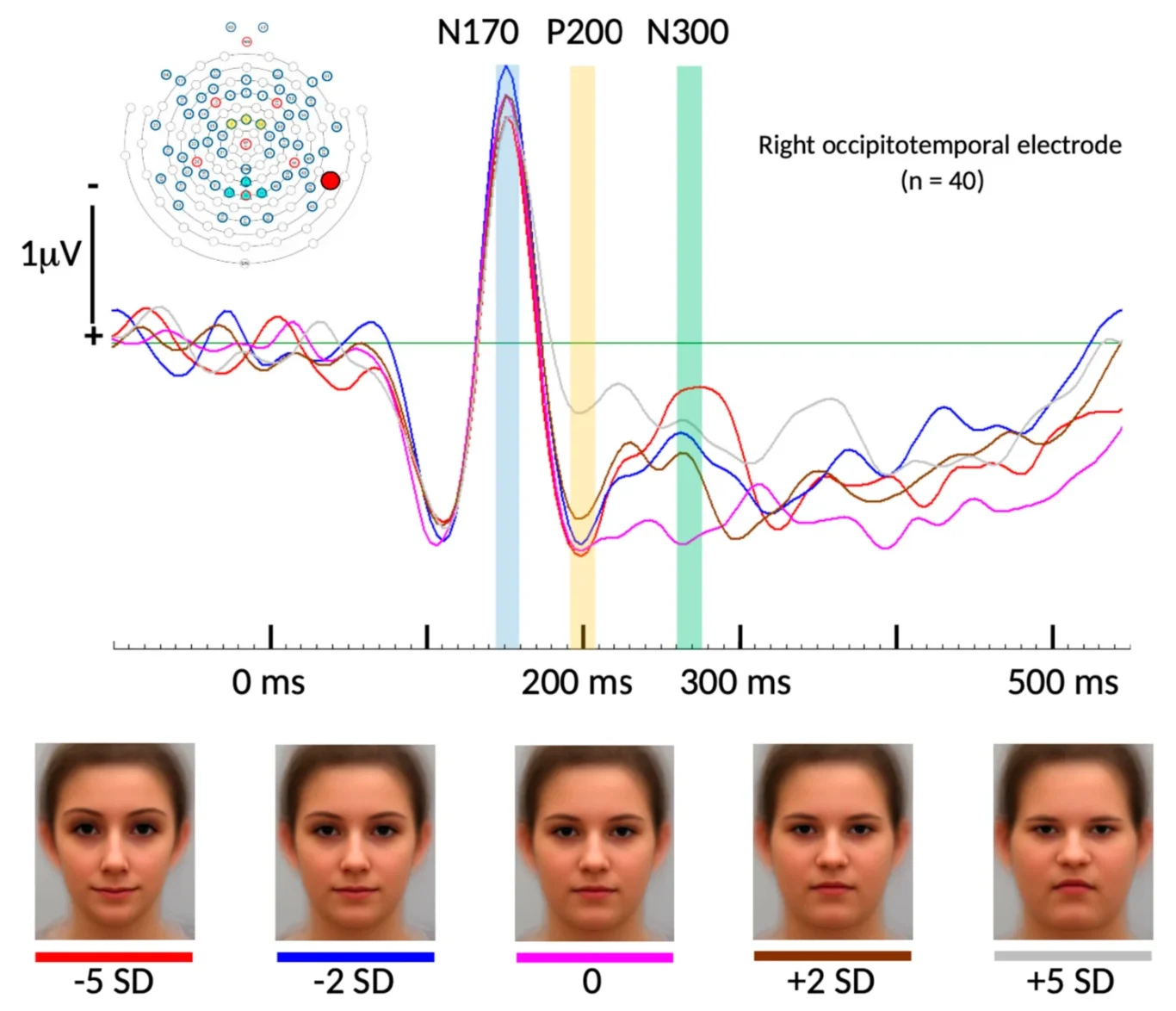
Abstract: The aim of this study was to investigate how a female face is perceived in terms of its attractiveness, dominance, health, femininity-masculinity, and maturity in direct relation to the body fat percentage (BFP) conveyed by the face. To compare how young adults (ages 18 to 35) respond to different levels of body fat percentage both subjectively and objectively we collected survey ratings and electroencephalography (EEG) data across five different levels of BFP from 40 participants. We adapted the experimental design from a prior behavioral study and used calibrated and morphed female face images of five different BFP levels. The results of the survey are in consensus with the previous study and assessed to be a successful replication. From the EEG data, event-related potentials (ERPs) were extracted from one electrode location (right occipitotemporal brain region) known to be particularly sensitive to face-stimuli. We found statistically significant differences in the amplitudes of the P200 component (194 ms post stimulus onset) between the thickest face and all four other BFP conditions, and in the amplitudes of the N300 component (274 ms post stimulus onset) between the average face and three other BFP conditions. As expected, there were no significant differences among the N170 amplitudes of all five BFP conditions since this ERP component simply reflects the processing of faces in general. From these results, we can infer that holistic face encoding characterized by the N170 component in the right occipitotemporal area is followed by serial evaluative processes, whose categorical and qualitative matrix and spatiotemporal dynamics should be further explored in future studies, especially in relation to the social constructs that were focused on in this study.
Electroencephalography (EEG) Reveals Increased Frontal Activity in Social Presence
Anna Soiné, Alessandra Natascha Flöck, Peter Walla
(Soiné, A.; Flöck, A.N.; Walla, P. Electroencephalography (EEG) Reveals Increased Frontal Activity in Social Presence. Brain Sci. 2021, 11, 731. https://doi.org/10.3390/brainsci11060731)
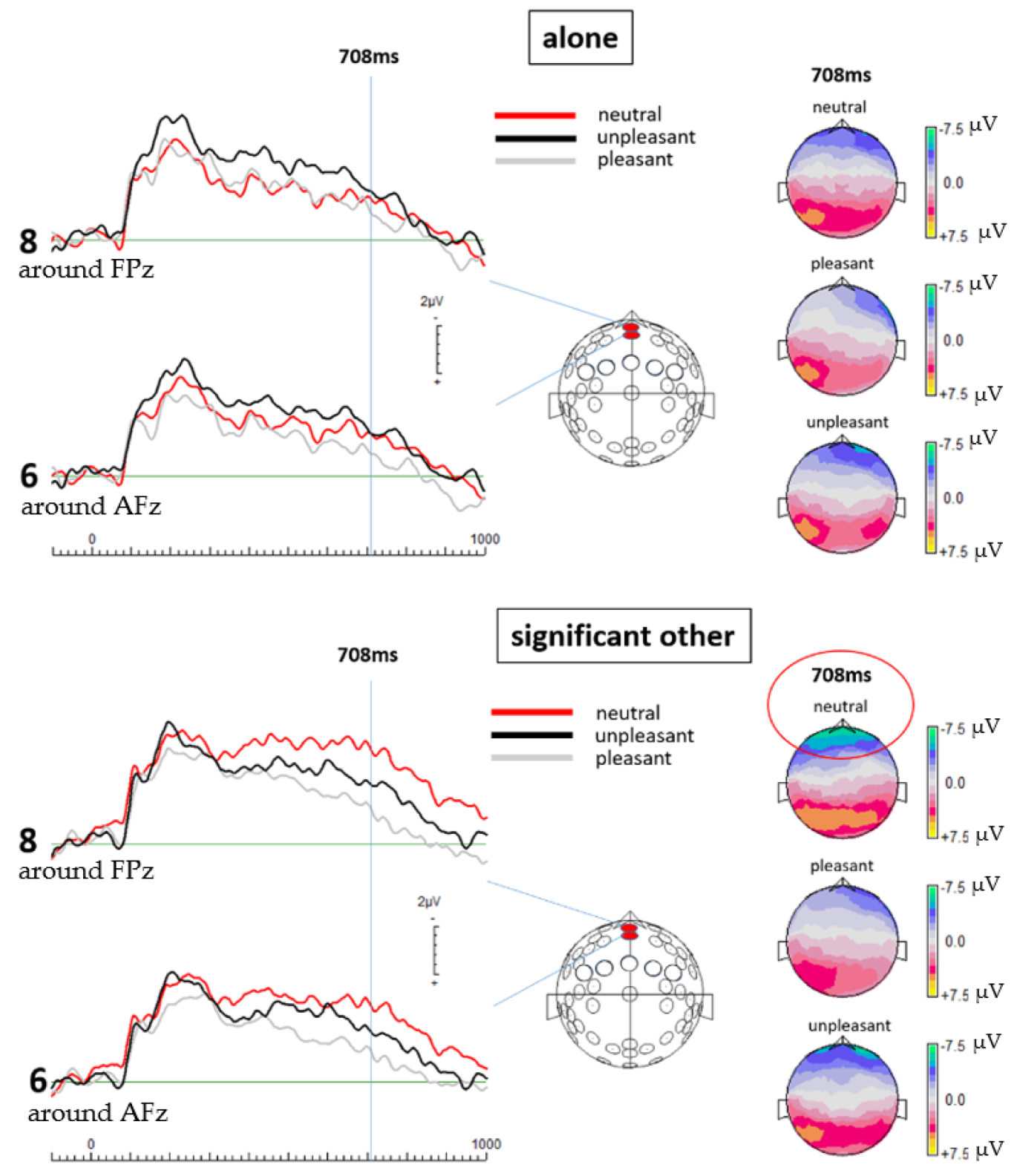
Abstract: It remains an unsolved conundrum how social presence affects the neural processes involved in adaptive situation-specific decision-making mechanisms. To investigate this question, brain potential changes via electroencephalography (EEG) and skin conductance responses (SCR) were taken within this study, while participants were exposed to pre-rated pleasant, neutral, and unpleasant pictures, which they had to rate in terms of their perceived arousal. Crucially, they had to—in respective runs—do this alone and in the presence of a significant other. Contrasting respective event-related potentials (ERPs) revealed significantly more negative going potentials peaking at 708 ms post stimulus onset at mid-frontal electrode locations (around FPz and AFz), when participants were exposed to neutral pictures while in the presence of a significant other. SCR results demonstrate higher states of arousal in the presence of a significant other regardless of picture emotion category. Self-reported arousal turned out to be highest in response to neutral pictures within the significant other condition, whereas in the alone condition in response to the pleasant pictures. In light of existing literature on social aspects and the anterior cingulate cortex (ACC), the ERP finding in the significant other condition, while rating emotionally neutral pictures, is interpreted as reflecting heightened ACC activation, which is supported by electrode locations showing significant brain activity differences as well as by source localization results. Neutral pictures are inherently ambiguous, and the current results indicate the presence of another person to change the way one processes, perceives, and acts on them. This is in support for theories proposing the ACC to be part of a larger signal-specification network that gauges relevant stimuli for adequate execution of control.
Sex-Determined Alteration of Frontal Electroencephalographic (EEG) Activity in Social Presence
Anna Soiné , Peter Walla
(Soiné, A.; Walla, P. Sex-Determined Alteration of Frontal Electroencephalographic (EEG) Activity in Social Presence. Life 2023, 13, 585. https://doi.org/10.3390/life13020585)
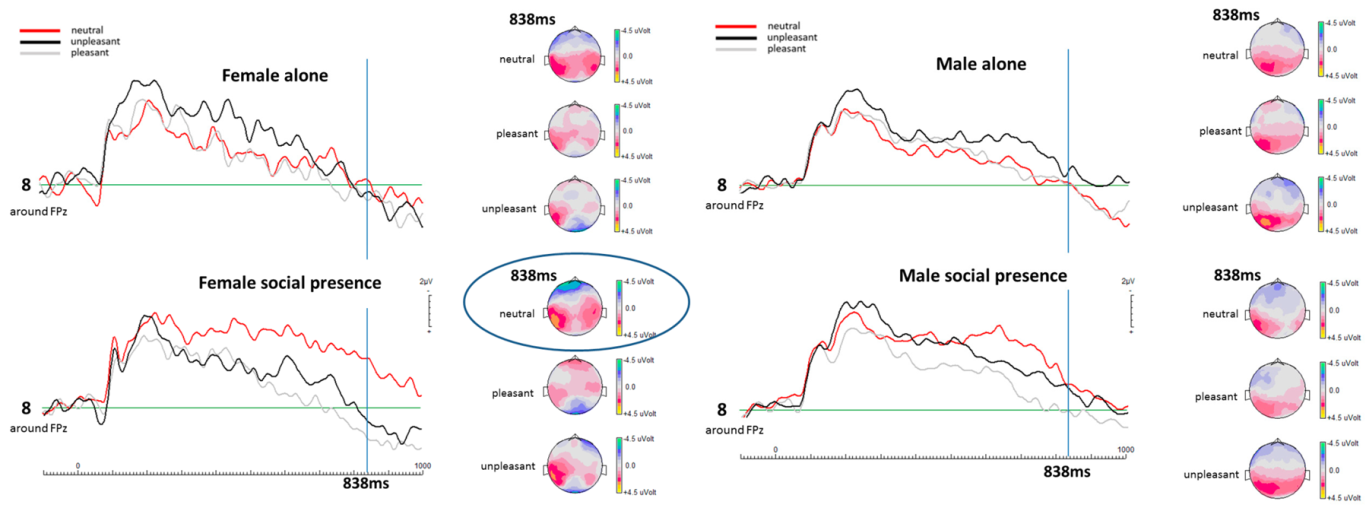
Abstract: This study represents a follow-up event-related potential (ERP) analysis of a prior investigation. The previous results showed that participants had most negative-tending ERPs in the mid-frontal brain region during exposure to neutral emotion pictures (compared to negative and positive pictures) while being accompanied by a significant other person (social presence condition). The present analysis aimed at investigating potential sex differences related to this phenomenon. Female and male participants’ brain activity data from the previous study were analyzed separately for one representative mid-frontal electrode location selected on the basis of having the highest significance level. As a result, only female participants showed significantly more negative-tending potentials in response to neutral pictures, compared to both other emotion categories (positive and negative) in the social presence condition. This was not found in male participants. The respective ERP effect was most dominant at 838 ms post stimulus onset, which is slightly later than the effect found in the prior study. However, this result is interpreted as evidence that the general effect from the prior study can be understood as a largely female phenomenon. In line with the prior study, the present results are interpreted as a predominantly female activation in the mid-frontal brain region in response to neutral picture stimuli while being accompanied by a significant other person (social presence condition). Although only speculative, this would align with previous studies demonstrating sex-related hormonal and structural differences in the anterior cingulate cortex (ACC). In general, ACC activation has been associated with an integrative weighting function in ambiguous social settings, which makes sense given the ambiguous nature of neutral pictures in combination with a social presence condition.
Subliminal Word Processing: EEG Detects Word Processing Below Conscious Awareness
Samuil Pavlevchev, Minah Chang, Alessandra Natascha Flöck, Peter Walla
(Pavlevchev, S.; Chang, M.; Flöck, A.N.; Walla, P. Subliminal Word Processing: EEG Detects Word Processing Below Conscious Awareness. Brain Sci. 2022, 12, 464. https://doi.org/10.3390/brainsci12040464)
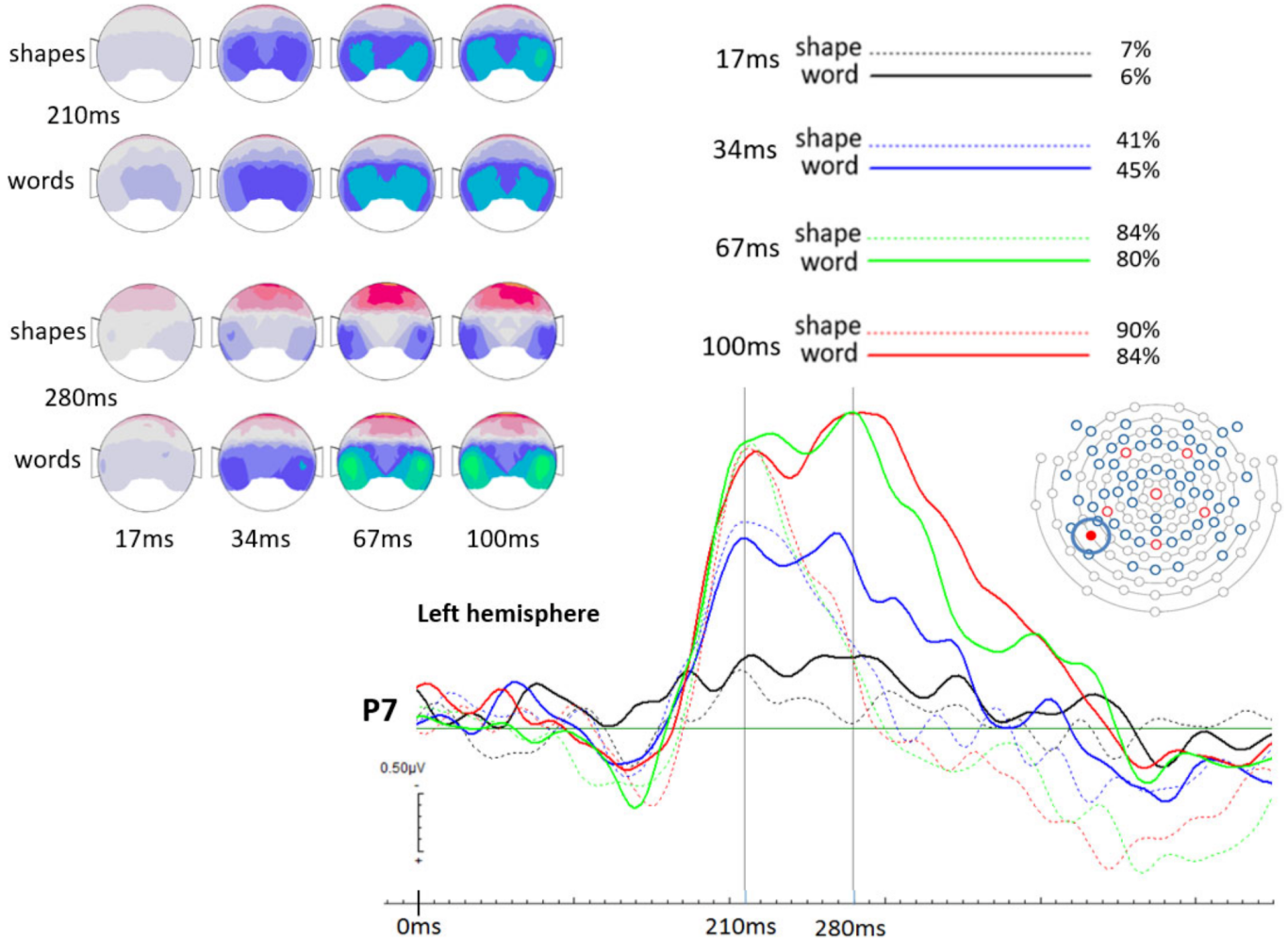
Abstract: The present electroencephalography (EEG) study observed how the brain processes visual stimuli (words and shapes) displayed with four different duration times (17 ms, 33 ms, 67 ms, and 100 ms). All stimuli had to be classified into “I saw nothing”, “I saw a blur”, “I saw a word,” or “I saw a shape” via distinct button presses while brain potentials were being measured. The neurophysiological correlates of word and shape processing were subsequently analysed and compared for two distinct time points at the occipito-parietal area in both hemispheres (P7 and P8). In a further step, word and shape identification rates were also analysed. Identification rates revealed that participants recognized words and shapes when presented for 17 ms at a rate of only 6% and 7%, which is poor enough to assume an overall lack of conscious recognition. Analysis of EEG data revealed two time points of interest, one at 210 ms and the other at 280 ms post stimulus onset. Brain potentials at the earlier time point reflect modulations in presentation duration with increased amplitudes elicited by longer presentations. At this time point, no differences were seen between words and shapes in both hemispheres. The later time point, though, clearly distinguished between word and shape processing with totally missing amplitudes (i.e., brain activity) in the case of shapes in general in both hemispheres. Crucially, words presented for only 17 ms still elicited an average brain potential amplitude significantly different from the corresponding 17 ms presentations of shapes at this time point at electrode location P7, even though both stimuli categories were basically not seen (i.e., not consciously recognized). This later word-specific brain potential for the shortest presentation duration is interpreted as neurophysiological evidence of subliminal word processing. Strikingly, this difference was not found in the right hemisphere at P8.
The Human Self Has Two Serial Aspects and Is Dynamic: A Concept Based on Neurophysiological Evidence Supporting a Multiple Aspects Self Theory (MAST)
Peter Walla, Georg Northoff, Cornelia Herbert
(Walla, P.; Northoff, G.; Herbert, C. The Human Self Has Two Serial Aspects and Is Dynamic: A Concept Based on Neurophysiological Evidence Supporting a Multiple Aspects Self Theory (MAST). Life 2021, 11, 611. https://doi.org/10.3390/life11070611)
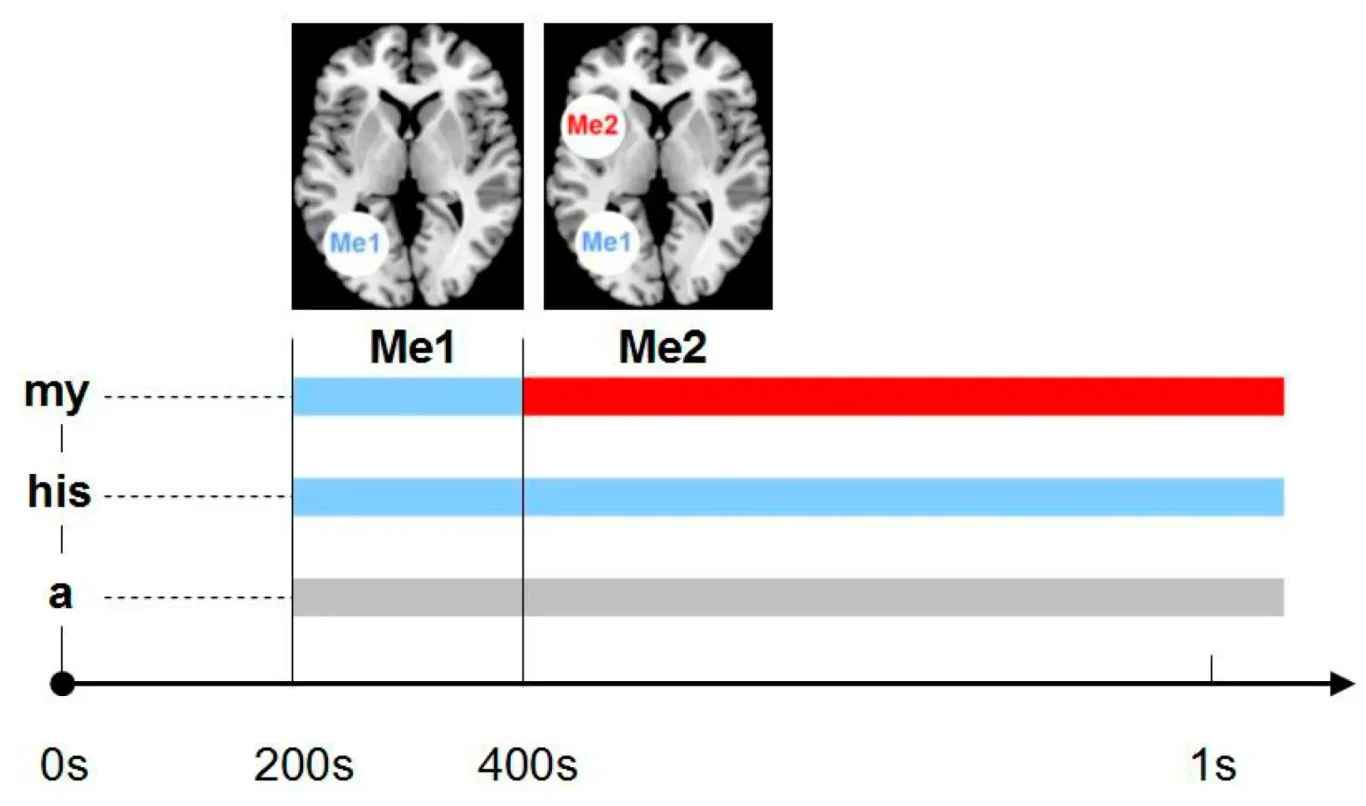
Abstract: The self is an increasingly central topic in current neuroscience. Understanding the neural processes that are involved in self-referential processing and functioning may also be crucial to understanding consciousness. The current short communication goes beyond the typical concept that the self is singular, as has been assumed from neuroanatomical descriptions of the self by fMRI and PET studies. Long ago, theoretically, the idea of multiple aspects of the human self-arose, highlighting a dynamic organizational structure, but an increasing number of electrophysiological brain imaging studies, searching for the temporal dynamics of self-referential brain processes, now has empirical evidence supporting their existence. This short communication focuses on the theoretical idea of a dynamic self and provides first preliminary empirical evidence, including results from own studies of the authors, in support of, and highlights the serial dynamics of the human self, suggesting a primitive Me1 and an elaborate Me2 (a non-personal and a personal self). By focusing on the temporal dimension of the self, we propose that multiple aspects of the self can be distinguished based on their temporal sequence. A multiple aspects Self Theory (MAST) is proposed. This model is meant as a theoretical framework for future studies providing further support.
